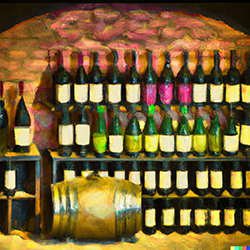Sulfites: Fact Vs. Fiction Part 2
Posted by Matteo Lahm on 9th Jan 2025
Part two of our article on Sulfites will discuss the history of its use in winemaking, its benefits and the pitfalls of omitting them. Part one was premised by a notion of purism in winemaking as a reason to avoid them. Some say that their grandparents never used them in their wine under the assumption that it was representative of a standard practice. In fact, that is the exception, not the rule. The history tells a very different story.
So how did the use of sulfites come about, and who came up with the idea? The Romans have a long and storied history of winemaking and spread viticulture to greater Europe. From the earliest days of the Roman Republic, wine was an important part of life and culture. It was used for everything from religious festivals to social gatherings and even medicinal purposes. As such, it is no surprise that the Romans developed innovative techniques to protect their precious drink from spoilage. One of these techniques was to use sulfur as a preservative.

Sulfur has been used as a preservative since ancient times, but it wasn’t until the Roman Empire that its use in winemaking became commonplace. The Romans had discovered that adding small amounts of sulfur to their wines not only helped to preserve them, but also enhanced the flavor and aroma of the drink. Sulfur not only kept wines from spoiling or becoming too sweet or sour, but also acted as a yeast suppressor which allowed for more consistent fermentation results.
The use of sulfur in winemaking spread far beyond the boundaries of Rome and eventually found its way into virtually every corner of Europe. It is clear that the Romans were well ahead of their time when it came to finding ways to preserve wine for extended periods of time without compromising its flavor or integrity. By taking advantage of natural ingredients like sulfur, yes sulfur is natural, they managed to create a safe and effective method for preserving their beloved beverage which would go on to be used around the world for centuries afterward.
Sulfites act as an antimicrobial agent, preventing the growth of undesirable microorganisms such as bacteria or fungi that may be present in grapes or other grape juice components. They reduce the rate at which oxidation occurs in wine, preserving its color and taste for longer periods of time. They also help stabilize proteins and tannins in red wines, producing more balanced flavors with softer tannins. Finally, sulfites can reduce bitterness in white wines without altering their aroma or flavor profile.
In addition to their practical uses, research has also shown that sulfites can actually enhance certain aspects of a wine’s flavor and aroma profile. For example, a study published in the Journal of Agricultural and Food Chemistry found that adding small amounts of SO2 to Chardonnay wines resulted in improved fruitiness and sweetness compared with unmodified samples. Additionally, another study observed that low levels increased the intensity of floral aromas in Sauvignon Blanc wines.
These two examples are of particular interest in that they are both white wines. Some who argue the veracity of the sulfite headache will drink whites thinking they don’t contain them when in fact they do.
Wines with higher levels of sulfur dioxide are less likely to suffer from oxidation-related problems such as browning or off-flavors while aging. Furthermore, these compounds can help maintain some level of clarity if a wine is stored incorrectly or exposed to extreme temperatures over long periods of time. By playing an active role in both preserving a wine’s quality over time and enhancing its flavor profile when consumed young, sulfites clearly have an important place within modern winemaking practices worldwide.

Now that we have clarified what sulfites do to improve your wine, let’s explore how excluding them is detrimental. Without SO2 present, wine can quickly become discolored and develop unpleasant off-flavors. Additionally, omitting sulfites can increase the likelihood of bacterial contamination even if proper sanitation practices are followed. This could lead to an unpleasant aroma or flavor profile in the finished product if bacteria are able to survive sterilization processes during bottling and packaging, which is more likely than not.
So, to get back to the concept of purism in early 20th century home winemaking practices, it could be argued that American winemakers did not use them because they didn’t have them. Many of these traditions came from Italian Americans so let’s look at Italian winemaking practices today. In Italy, you can buy a wine called Vino Sfuso. It is table wine made locally from local grapes. Vino Sfuso is sold in small wineries and in supermarkets but it is not bottled. It is in large variable steel tanks and customers fill the bottles themselves. Some people even bring their own. You would think that if there was a kind of wine that did not contain sulfites, this would be it. Guess again. Vino Sfuso contains sulfites.
That said, there is one kind of wine that does not. It is called Novello which infers new wine. It is from the current year’s harvest that is filtered and sold with no aging. It is only available during the fall after the harvest season because without sulfites it does not last. It is important to note that they do not omit the sulfites for any other reason than their immediate effect on the taste. Wine that contains sulfites is meant to have some degree of bottle aging, even a few months which is enough time for the flavor of sulfites to disappear. Adding them to wine that is meant to be drunk immediately won’t work.
We hope you have enjoyed this report on sulfites and that we could bring clarity to what is clearly a touchy subject to some. The inevitable conclusion is that sulfites are safe. We consume them every day in many foods, some of which like bacon and raisins contain more sulfites than wine. Without the addition of sulfites during winemaking, aging your wines would be virtually impossible due to rapid oxidation and spoilage caused by microorganisms over time. Indeed, it could be argued that without the addition of sulfites, we would not have access to some of the world's finest aged wines, which underscores the importance and necessity of their use in modern day winemaking practices.
In summary, this article has sought to dispel some common misconceptions surrounding sulfites while also discussing their role in protecting against oxidation and other harmful elements that would otherwise affect the quality and longevity of wine. By understanding why these compounds are necessary for proper preservation, we can better appreciate their importance and value in producing quality aged wines for our enjoyment without worry about dangers or getting sidetracked by misconceptions that don’t have any basis in fact.
As you have read in part one and now, part two, it is evident that not only can you not age your wine without sulfites, you cannot even avoid consuming them. They are in the food you eat, the soil where your food is grown, in the air you breath and even occur naturally in your body. Therefore, if you’re going to go through all the trouble to put your heart and soul into your craft, you might as well protect your wine while you’re at it.

